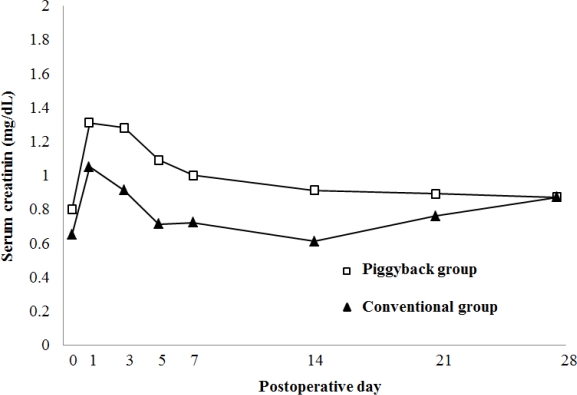Comparing Renal Function After Liver Transplantation: Modified Piggyback versus Conventional Techniques without Venovenous Bypass.
Surgery, Yonsei University College of Medicine, Seoul, Korea.
Meeting: 2016 American Transplant Congress
Abstract number: B181
Keywords: Cadaveric organs, Liver transplantation, Renal function, Renal injury
Session Information
Session Name: Poster Session B: Kidney Issue in Liver Transplantation
Session Type: Poster Session
Date: Sunday, June 12, 2016
Session Time: 6:00pm-7:00pm
 Presentation Time: 6:00pm-7:00pm
Presentation Time: 6:00pm-7:00pm
Location: Halls C&D
Background
There are several options available for caval reconstruction in liver transplantation. Prior reports demonstrated that caval reconstruction technique could affect the renal function. However, there is no clear evidence that any surgical technique is better than another in liver transplantation. The aim of this study was to compare the renal function according to the caval reconstruction techniques in the modern era.
Methods
A retrospective analysis was undertaken of 91 deceased donor liver transplantations in adult patients treated between January 2013 and August 2015 (57 conventional without venovenous bypass (VVB), 34 modified piggyback techniques). Postoperative renal function and need for continuous renal replacement therapy (CRRT) up to first months after transplantation were analyzed.
Results
The need for CRRT was significantly higher in piggyback group than in conventional group (26.3% vs. 5.9%, p = 0.016). During 2 weeks after transplantation, mean serum creatinine was significantly higher in piggyback group than in conventional group. There was no significant difference in serum creatinine between two groups at 1 month. Two cases of venous outflow obstruction occurred in piggyback group (3.5%). There were no significant differences between two groups in terms of warm ischemic time, consumption of blood components, and hospital stay.
Conclusion
With improvement in surgical technique and anesthetic management, conventional techniques can be performed safely without VVB. Conventional technique without VVB might reduce the need for CRRT after liver transplantation.

CITATION INFORMATION: Lee J, Lee J, Song S, Lee J, Kwon S.-K, Han D, Ju M, Choi G, Choi J, Kim M, Kim S, Joo D. Comparing Renal Function After Liver Transplantation: Modified Piggyback versus Conventional Techniques without Venovenous Bypass. Am J Transplant. 2016;16 (suppl 3).
To cite this abstract in AMA style:
Lee J, Lee J, Song S, Lee J, Kwon S-K, Han D, Ju M, Choi G, Choi J, Kim M, Kim S, Joo D. Comparing Renal Function After Liver Transplantation: Modified Piggyback versus Conventional Techniques without Venovenous Bypass. [abstract]. Am J Transplant. 2016; 16 (suppl 3). https://atcmeetingabstracts.com/abstract/comparing-renal-function-after-liver-transplantation-modified-piggyback-versus-conventional-techniques-without-venovenous-bypass/. Accessed December 12, 2025.« Back to 2016 American Transplant Congress
